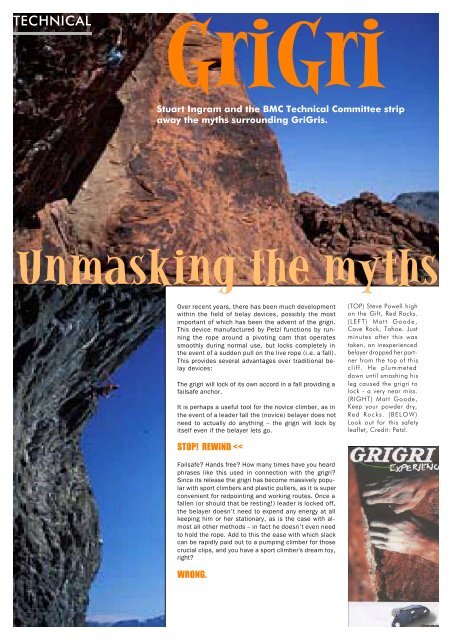Create successful ePaper yourself
Turn your PDF publications into a flip-book with our unique Google optimized e-Paper software.
TECHNICAL<br />
GriGri<br />
Stuart Ingram and the BMC Technical Committee strip<br />
away the myths surrounding GriGris.<br />
Unmasking the myths<br />
Over recent years, there has been much development<br />
within the field <strong>of</strong> belay devices, possibly the most<br />
important <strong>of</strong> which has been the advent <strong>of</strong> the <strong>grigri</strong>.<br />
This device manufactured by Petzl functions by running<br />
the rope around a pivoting cam that operates<br />
smoothly during normal <strong>use</strong>, but locks completely in<br />
the event <strong>of</strong> a sudden pull on the live rope (i.e. a fall).<br />
This provides several advantages over traditional belay<br />
devices:<br />
The <strong>grigri</strong> will lock <strong>of</strong> its own accord in a fall providing a<br />
failsafe anchor.<br />
It is perhaps a <strong>use</strong>ful tool for the novice climber, as in<br />
the event <strong>of</strong> a leader fall the (novice) belayer does not<br />
need to actually do anything – the <strong>grigri</strong> will lock by<br />
itself even if the belayer lets go.<br />
STOP! REWIND
Recently, at a climbing wall near you:<br />
On nearing the top <strong>of</strong> a route around the limit <strong>of</strong> his ability,<br />
a climber throws a long dyno for the finishing jug. He gets<br />
agonisingly close to sticking it but he’s tired (it’s the end <strong>of</strong><br />
his session), and slowly peels backwards expecting only a<br />
short fall as there’s a bolt by his waist. After cratering onto<br />
the concrete floor 10m below, the climber and his belayer<br />
try to figure out what went wrong.<br />
Rope: 10.5mm diameter, nearly new, good condition<br />
Belayer: 10 years experience and <strong>use</strong>s a <strong>grigri</strong> regularly<br />
Protection: bolt at the waist <strong>of</strong> the climber, almost no slack<br />
in the rope<br />
Fall: very gradual and slow<br />
The last two points are the important ones – there was no<br />
slack in the rope and the fall was very gradual, resulting in<br />
almost no shock loading to the system. Now, the <strong>grigri</strong> works<br />
by arresting a fall when its pivoting cam locks after a sudden<br />
load. If this sudden loading is absent, rope may run through<br />
the device without locking the cam to such an extent that an<br />
incident such as the above becomes possible – especially if<br />
the belayer is holding or pinching the device in any way. The<br />
fact that the rope in <strong>use</strong> was nearly new and probably quite<br />
“slick” may have also contributed.<br />
Near-miss <strong>of</strong> the year:<br />
You’re at the last couple <strong>of</strong> moves before the chain, but<br />
those forearms are totally maxed, fingers opening, feet skating<br />
– this is a route for another day.<br />
Luckily, you just clipped a bolt and can<br />
sit on it and rest rather than take the<br />
fall. The next instant, you’re decking<br />
out on rope stretch 15 metres down –<br />
what’s up with that? Thankfully uninjured<br />
but very psyched out, you begin<br />
the analysis:<br />
Belayer: had been climbing indoors<br />
for 6 months and had recently started<br />
using a <strong>grigri</strong><br />
Protection: again, a bolt by the waist<br />
Fall: not even a fall really, just slowly<br />
and gradually sitting on the rope<br />
Is there a pattern forming<br />
here?<br />
In this incident, we have a very similar<br />
situation with the climber weighting the<br />
rope in such a way as to provide insufficient<br />
“shock” to allow the <strong>grigri</strong> to<br />
lock and arrest the fall. In this case<br />
the <strong>grigri</strong> did eventually lock, most probably beca<strong>use</strong> the<br />
belayer suffered serious rope burns on her right hand, causing<br />
her to leave go <strong>of</strong> the dead rope and step backwards.<br />
Presumably, this changed the orientation <strong>of</strong> the device and<br />
allowed it to lock. These two (real) incidents present us with<br />
an uncomfortable fact:<br />
Myth: The <strong>grigri</strong> will always lock <strong>of</strong> its own accord in the<br />
event <strong>of</strong> a fall, providing a failsafe anchor.<br />
Reality check: If there is no initial shock loading<br />
or sudden pull on the rope, the device<br />
may not lock AT ALL!<br />
Right now you’re thinking “Wait a second, nobody told me<br />
about this when I bought the thing!” Read on…<br />
Lowering <strong>of</strong>f….<br />
It’s all over when you clip the chains, ain’t it? Think again -<br />
several climbers have reported near-misses or ground falls<br />
whilst lowering <strong>of</strong>f a route. These can be wholly put down to<br />
<strong>use</strong>r error, since the <strong>grigri</strong> must already be operating correctly<br />
for a lower to commence unless the situation is similar to the<br />
above near miss, and the <strong>grigri</strong> doesn’t lock in the first place.<br />
In theory, there are two ways to control a lower with a <strong>grigri</strong> –<br />
varying the position <strong>of</strong> the lowering handle and thus the cam<br />
trapping the rope (easier) or with the dead rope, holding the<br />
lowering handle open but not varying its position (safer, and<br />
the recommended method). In practice, the lower is controlled<br />
with a mixture <strong>of</strong> these two, and if the lower begins to get<br />
fast it's easy for an (inexperienced) <strong>use</strong>r to conf<strong>use</strong> the two<br />
methods and adjust the wrong way, allowing free passage <strong>of</strong><br />
the rope through the device – bad news.<br />
Beware “The Thumb”<br />
Most <strong>grigri</strong> <strong>use</strong>rs will be aware <strong>of</strong> the trick <strong>of</strong> pushing on the<br />
barrel <strong>of</strong> the lowering handle with a thumb, thus depressing<br />
the cam and allowing slack to be yarded out very quickly to<br />
a quivering leader. Great – he makes the clip and avoids a<br />
fall. But think about what you just did. Whilst you were depressing<br />
the cam, you were deliberately preventing the device<br />
from locking (to pay out slack), so what if your leader<br />
fell whilst you were doing this and before he clipped? BANG<br />
– deck out; almost certainly the <strong>grigri</strong> would fail to lock.<br />
Myth: Rope is paid out to the leader by depressing the<br />
cam lever with the thumb and pulling out the live<br />
rope.<br />
Reality check: This is UNSAFE! If the<br />
leader falls while you’re doing this,<br />
chances are the <strong>grigri</strong> WILL NOT<br />
LOCK!<br />
HOW NOT TO DO IT!<br />
Is this you? Your thumb slowly<br />
creeping over the <strong>grigri</strong>,<br />
stopping the device from<br />
working properly.
TECHNICAL<br />
CORRECT - A hand is always kept on the live rope, just like<br />
a traditional belay device.<br />
What now?<br />
Before you drop your <strong>grigri</strong> in the trash and buy a Sticht plate,<br />
let’s turn around and get some perspective here. There are<br />
only a very few incidents like these each year, and when you<br />
compare the huge number <strong>of</strong> <strong>use</strong>r hours, it becomes obvious<br />
that the <strong>grigri</strong> is a very safe and effective device in the hands<br />
<strong>of</strong> an experienced <strong>use</strong>r. It’s very important to be clear about<br />
this next bit:<br />
Petzl have never marketed the device<br />
as a “hands-free” or “failsafe” belay<br />
device, and have always recommended<br />
that it is for expert <strong>use</strong> only.<br />
They even went to the extent <strong>of</strong> providing any interested parties<br />
(i.e. climbing walls, outdoor centres) with a free <strong>use</strong>r advice<br />
poster and leaflet showing how to <strong>use</strong> one safely when these<br />
incidents began to come to light - respect due. The problem is<br />
the popular opinion that has evolved amongst climbers, that the<br />
<strong>grigri</strong> cannot fail in <strong>use</strong> (“It’s an autolocking device, how can it<br />
fail?” says one climber to another…) – not true.<br />
Testing the theory<br />
Staff at the National Mountain Centre, Plas-y-Brenin conducted<br />
some experiments based on the circumstances <strong>of</strong> the<br />
above incidents, in conjunction with the BMC Technical Committee.<br />
Various hand/device configurations were tested with<br />
a climber slumping from an overhanging wall onto a high runner<br />
or falling from above the runner. Findings supported similar<br />
Lyon Equipment tests with normal <strong>use</strong> <strong>of</strong> the device: all<br />
types <strong>of</strong> fall were held. However, w hen paying out rope for the<br />
lead climber to clip a runner it was a different story. If the<br />
plastic lever part <strong>of</strong> the device was held down the device<br />
failed to grip and would only hold a fall if the belayer had the<br />
presence <strong>of</strong> mind to release the lever<br />
area or let go <strong>of</strong> the device altogether.<br />
In other words, pro<strong>of</strong> that <strong>use</strong> <strong>of</strong> “the<br />
thumb” is a dubious and dangerous<br />
game – as shown in the Petzl leaflet<br />
and poster.<br />
Use it right<br />
At first reading it might seem as if this<br />
article sets out to demonise the <strong>grigri</strong><br />
as a dangerous, unpredictable device<br />
that will drop your leader if you so<br />
much as look at it wrongly. Absolutely<br />
the opposite – the aim here is to illustrate<br />
some <strong>of</strong> the popular misconceptions<br />
that have grown regarding its <strong>use</strong>,<br />
and to dispel the notion that it is a<br />
foolpro<strong>of</strong> device. As with any other piece <strong>of</strong> climbing gear<br />
it most definitely isn’t, and it takes proper instruction and<br />
experience to <strong>use</strong> correctly. In the right hands the <strong>grigri</strong> is<br />
a safe and incredibly convenient tool for belaying (amongst<br />
other <strong>use</strong>s) and <strong>of</strong>fers significant advantages over some<br />
other methods when sport or indoor climbing.<br />
But only if you switch on and <strong>use</strong> it properly!<br />
SAFETY SUMMARY<br />
· Recommended for <strong>use</strong> after expert instruction only!<br />
CORRECT Keep that hand on<br />
whilst lowering<br />
· Don’t <strong>use</strong> “the thumb” – always pay out slack to the<br />
leader as if using a traditional belay plate. This may earn<br />
you curses for a failed redpoint, but praise in the end for<br />
not allowing your leader to deck.<br />
· Leaders: if you’re going to sit on the rope without falling,<br />
tell your belayer you are about to do it, so they can make<br />
sure the <strong>grigri</strong> locks.<br />
· Monitor the flow <strong>of</strong> the rope through the device at all<br />
times. Forget we put the words “failsafe” and “handsfree”<br />
at the start <strong>of</strong> this piece, and <strong>use</strong> the <strong>grigri</strong> with as<br />
much care and attention as any other piece <strong>of</strong> gear.<br />
· Take extra care with skinny ropes as they <strong>of</strong>fer less friction,<br />
and thus more potential for non-locking situations<br />
than fat ones. In their catalogue, Petzl recommend between<br />
“10-11mm single ropes only (9.7mm accepted)”<br />
– obviously, the beefier your rope, the greater your margin<br />
<strong>of</strong> safety all round.<br />
- Finally, if you happen to be using a <strong>grigri</strong> and it fails to<br />
lock in a fall situation, try to do something to give the rope/<br />
device the initial “jerk” it needs to lock up. Step back,<br />
yank hard on the rope (dead or live), or in extremis move<br />
the device itself to a different orientation – though you risk<br />
depressing the cam and preventing locking if you do this.<br />
However, prevention is always better than cure and by<br />
following the guidance above and keeping with the program<br />
when belaying, you should never experience a failure<br />
in <strong>use</strong>.<br />
More information<br />
More information on the <strong>grigri</strong>, its safe <strong>use</strong> and other applications<br />
can be found at www.petzl.com, or via Lyon Equipment<br />
(01539 625493 – www.lyon.co.uk). Thanks go to<br />
both these companies and Ben Lyon for their input into<br />
this article.<br />
28 BMC SUMMIT - ISSUE 23
















